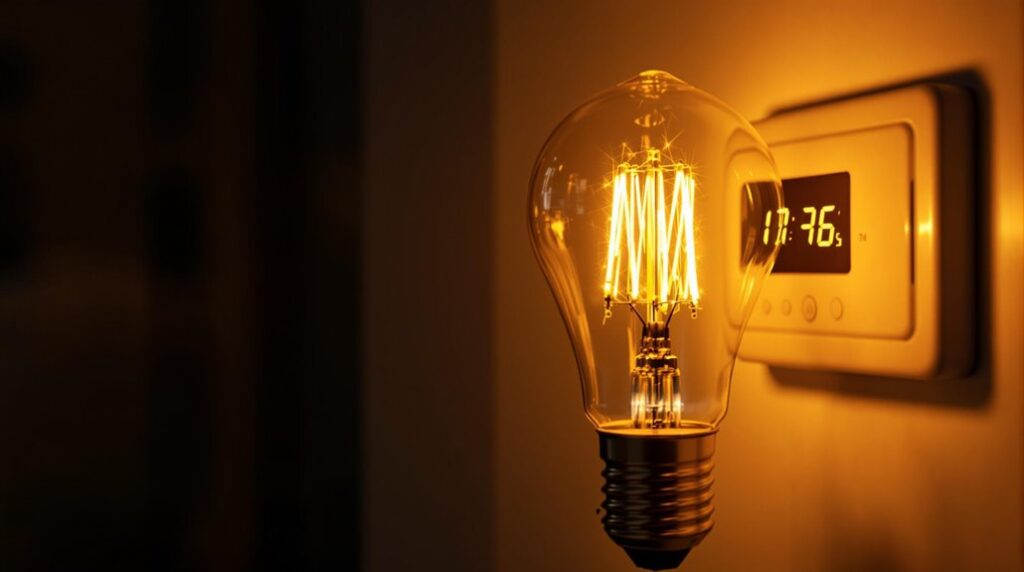I’ll show you exactly how much electricity your light bulbs consume and why it’s costing you more than you think. Most homeowners don’t realize that their lighting accounts for 10-15% of their monthly electric bill, with traditional incandescent bulbs burning through 60-100 watts per hour. When you’re running multiple bulbs for several hours daily, those watts add up fast. Here’s what I’ve discovered about the real numbers behind your lighting costs.
Key Takeaways
- LED bulbs use 2-18 watts compared to incandescent bulbs’ 25-100 watts for equivalent brightness levels.
- A 60W incandescent bulb costs $6.57 annually while a 10W LED costs only $1.10 yearly.
- Switching ten 60W bulbs to LEDs saves 91.8 kWh monthly, reducing bills by $165 annually.
- LED bulbs use 75% less energy than incandescent and last 25 times longer, maximizing savings.
- Lighting accounts for 25-30% of monthly electric bills, making efficient bulbs crucial for cost reduction.
Understanding Light Bulb Wattage by Type
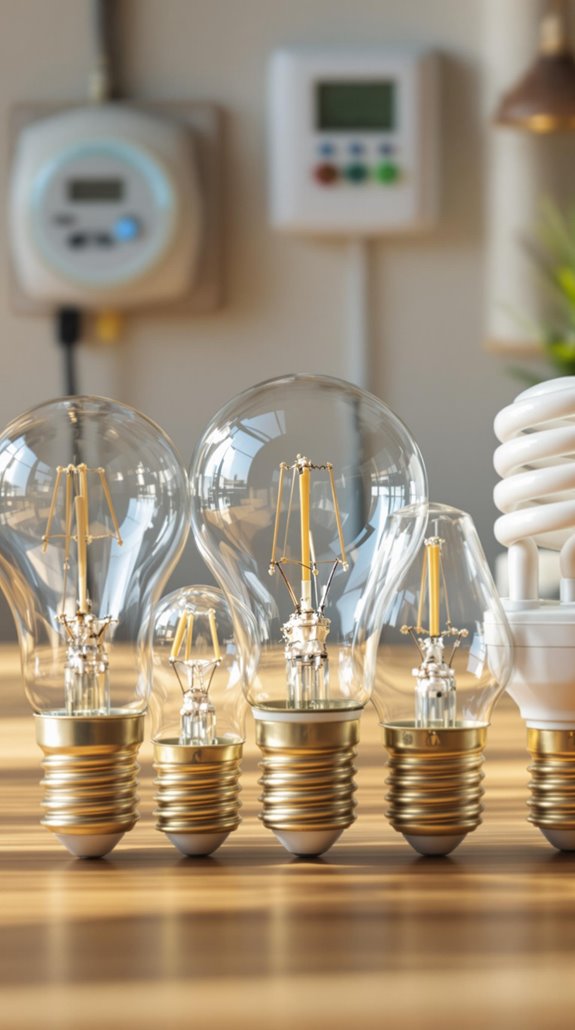
When shopping for light bulbs, understanding wattage differences between bulb types will directly impact your electricity bill. I’ve found that traditional incandescent bulbs consume 25 to 100 watts, making them the most energy-hungry option. LED bulbs use just 2 to 18 watts while delivering equivalent brightness. CFL bulbs fall in between at 8 to 30 watts, though they’re being phased out in many areas.
Here’s what matters for your wallet: halogen bulbs require 10 to 52 watts, still much higher than LEDs. Most household lamp fixtures have a 60-watt maximum, but you’ll never hit that limit with LEDs. For example, a 9-watt LED produces the same light as a 60-watt incandescent. That’s where real savings begin.
The financial impact becomes clear when you calculate annual costs – upgrading from 60-watt incandescents to 10-watt LEDs can save up to $300 annually in a typical 2,000-square-foot house.
Daily Electricity Consumption Breakdown
Since your electricity bill depends on actual daily usage, I’ll break down exactly how much power different bulbs consume during typical household operation.
For 6 hours of daily use, here’s what you’ll see on your meter:
Incandescent bulbs hit your wallet hardest – a 60W bulb uses 0.36 kWh daily, while a 100W bulb consumes 0.60 kWh.
CFL bulbs cut consumption remarkably – a 14W CFL (60W equivalent) uses just 0.084 kWh daily, saving you 77% compared to incandescent.
LED bulbs deliver maximum savings – a 9W LED (60W equivalent) consumes only 0.054 kWh daily, that’s 85% less than incandescent. The superior energy efficiency of LEDs means they produce more light output while consuming significantly less electrical power than traditional lighting options.
The difference compounds quickly across multiple fixtures, making bulb choice your biggest lever for controlling lighting costs.
Monthly Energy Usage Calculations
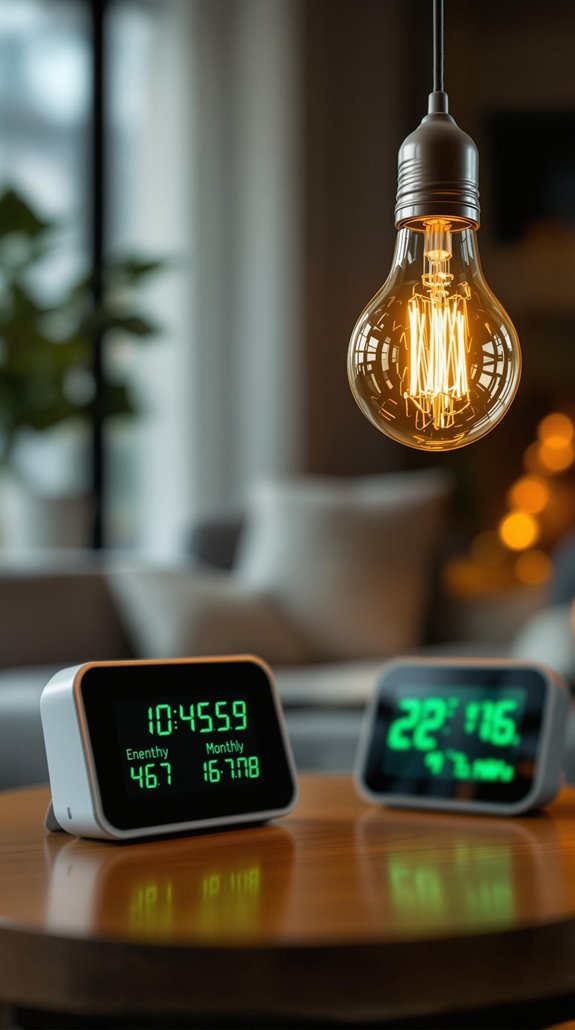
Your monthly electricity bill reflects the cumulative impact of these daily consumption patterns across 30 days of consistent use. I’ll show you the straightforward calculation: multiply your bulb’s wattage by daily hours, then by 30 days, and divide by 1,000. For example, that 60W incandescent running 4 hours daily costs you 7.2 kWh monthly, while a 9W LED equivalent uses just 1.62 kWh.
Here’s what we’re really dealing with: switching ten 60W bulbs to LEDs saves 91.8 kWh monthly—that’s $165 annually at typical rates. I’ve seen commercial buildings cut consumption from 1,800 kWh to 270 kWh by replacing 100W incandescents with 15W LEDs. Beyond energy savings, LED bulbs offer a longer lifespan than both incandescent and CFL options, reducing replacement frequency and maintenance costs. Remember, real-world usage varies ±10% due to voltage fluctuations and bulb age, but these calculations give you solid planning numbers.
Annual Power Consumption Analysis
Looking at twelve months of lighting costs reveals the true financial impact of your bulb choices. I’ve analyzed the annual consumption data, and the differences are staggering.
A 100W incandescent bulb running 6 hours daily consumes 219 kWh annually, while a 15W LED uses just 32.4 kWh – that’s 186.6 kWh saved per bulb. For moderate use scenarios, a 60W incandescent at 2 hours daily still uses 43.8 kWh compared to a 10W LED’s 7.3 kWh.
You’re looking at 75-90% energy reductions by switching to LED technology. If you’re running multiple bulbs throughout your home, these savings multiply quickly. Each efficient bulb replacement can save over 200 kWh annually in high-use areas, translating to substantial bill reductions. With average light usage in U.S. homes being approximately 2 hours per day, these consumption patterns represent typical household lighting behavior.
Real Cost Impact on Your Electric Bill

How dramatically will switching bulbs affect your monthly electric bill? I’ve found that lighting represents 25-30% of your average monthly electric bill, making bulb efficiency essential for cost control. When I calculate real savings, replacing just 20 incandescent bulbs with LEDs saves over $100 annually—that’s immediate money back in your pocket.
Here’s what I’ve discovered: a 60W incandescent costs $6.57 yearly, while its 10W LED equivalent costs only $1.10. That’s $5.47 saved per bulb annually. For households with extensive lighting, you’re looking at substantial monthly reductions. Additionally, ENERGY STAR certified LED bulbs provide even greater efficiency guarantees, ensuring you get maximum performance while consuming the least energy possible.
I recommend focusing on your most-used fixtures first. High-traffic areas like kitchens and living rooms deliver the biggest bang for your buck. Smart usage habits—turning off unused lights—can slash lighting costs by 20-30% immediately.
LED Vs Incandescent: the Shocking Savings
Here’s what you’re facing: incandescent bulbs consume 60 watts while LEDs use just 10 watts for equivalent brightness. That’s consuming only 20-25% of the energy for the same light output.
Let me break down your annual costs. Using one bulb for 2 hours daily, you’ll spend $6.22 with incandescent versus $1.04 with LED. That’s $23.36 in savings per bulb annually. Additionally, draft-proofing front doors can further enhance your energy savings by improving home insulation.
The efficiency gap is massive – LEDs produce 50 lumens per watt compared to incandescent’s measly 13 lumens per watt. Since incandescent bulbs waste 90% of electricity as heat, you’re literally paying to heat your home inefficiently while barely illuminating it.
Beyond the immediate energy savings, LED bulbs can last 50,000 hours compared to incandescent’s mere 1,000 hours, dramatically reducing your replacement frequency and maintenance headaches.
Smart Usage Strategies to Cut Energy Waste
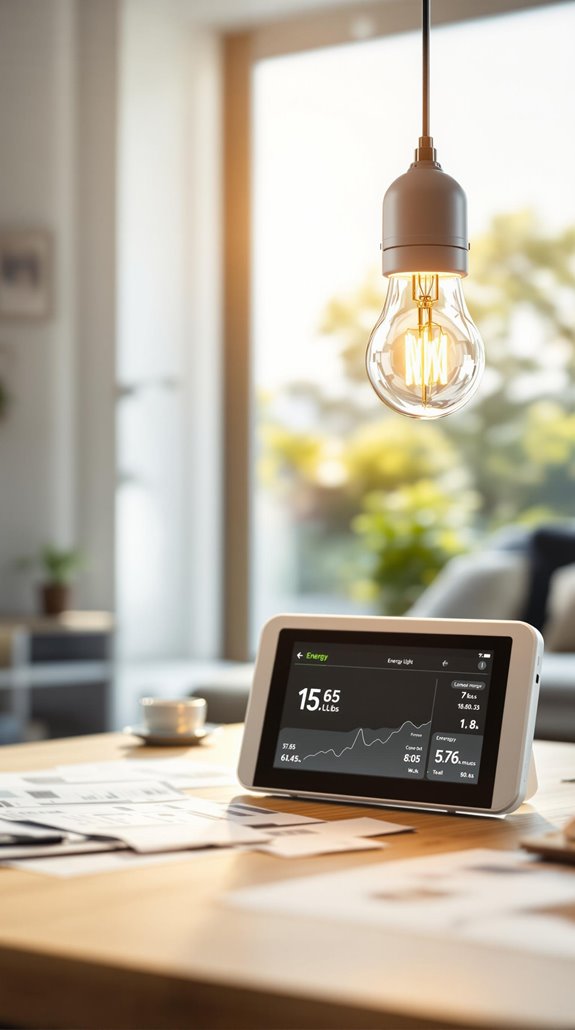
Since you’ve already chosen energy-efficient bulbs, maximizing their potential requires strategic usage patterns that’ll slash your electricity consumption by an additional 30-40%. I’ll show you how to eliminate the wasteful habits that drain your wallet.
First, control your daily usage duration by turning off lights in unoccupied rooms and utilizing natural daylight whenever possible. You’re literally throwing money away with unnecessary illumination. Improving your home’s insulation quality can also enhance overall energy efficiency, further reducing costs.
Deploy smart automation tools like motion sensors and geofencing to activate lights only when you’re home. Program sunrise/sunset timers through apps to sync with natural light cycles.
Optimize brightness settings by dimming lights to 50-70% for ambient tasks. You don’t need full brightness for every activity. Consider installing smart plugs to remotely monitor and control your lighting energy usage throughout your home.
Finally, mitigate standby power drain by selecting bulbs with consumption below 0.5 watts during standby mode. By being mindful of your lighting habits, you can significantly lower your energy expenses while maintaining comfort.
Energy-Efficient Bulb Technologies Explained
Beyond implementing smart usage habits, selecting the right bulb technology directly impacts your electricity bills and long-term savings. I’ll break down your four main options to help you make the smartest choice for your wallet.
LED bulbs are the clear winner—they use 75% less energy than incandescent bulbs while lasting 25 times longer. You’ll spend about $1.20 annually per bulb versus $7.20 for incandescent at typical usage rates. These bulbs can last up to 100,000 hours with proper use, making them exceptional long-term investments.
CFL bulbs offer solid savings too, consuming 70-80% less energy with lower upfront costs than LEDs. However, they contain mercury requiring special disposal.
Halogen bulbs provide 25-30% efficiency gains over incandescent but still lag behind LED and CFL options.
Skip incandescent entirely—they waste 90% of energy as heat.
Solar-Powered Lighting Solutions
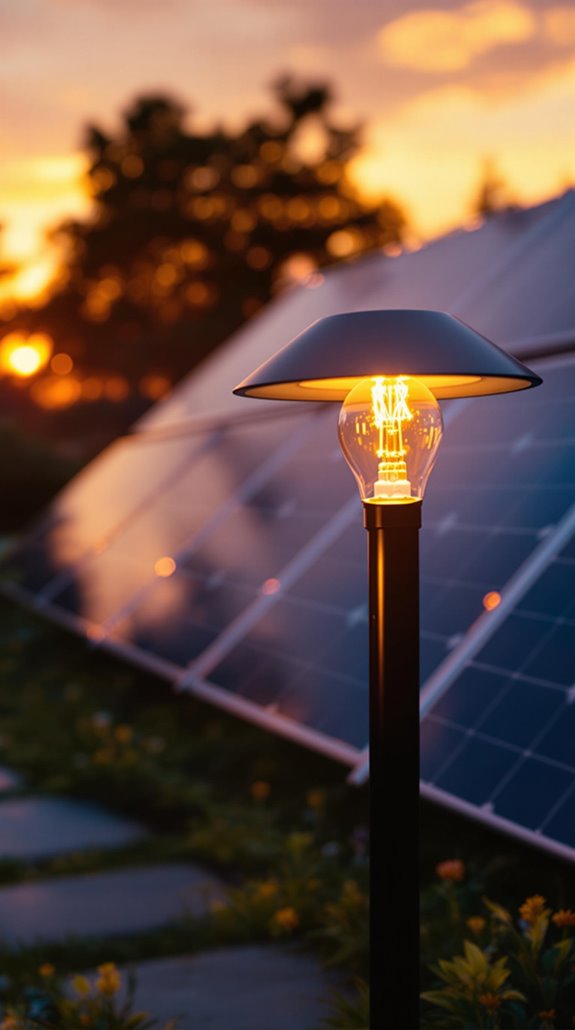
Solar-powered lighting systems eliminate your electricity costs entirely by converting sunlight into stored energy through photovoltaic panels. I’ve found these systems particularly valuable because they harness daylight to charge batteries, then automatically activate LED bulbs at dusk through integrated sensors. Additionally, these systems can provide a cost-effective alternative to traditional heating methods that often rely on fossil fuels.
You’ll appreciate the impressive efficiency gains – LED technology generates light up to 90% more efficiently than traditional bulbs, while lasting tens of thousands of hours. The initial investment pays off quickly since you’re completely independent from grid power, avoiding monthly electricity bills.
The system’s components work seamlessly together: photovoltaic panels capture sunlight, batteries store energy for nighttime use, and controllers regulate power flow. These systems maintain functionality even during On-Grid power failures, ensuring your lighting remains reliable when traditional electrical systems fail. You’ll eliminate trenching costs and wiring expenses while joining the growing community of homeowners who’ve achieved energy independence through smart lighting choices.
Conclusion
I’ve broken down exactly how much electricity your bulbs consume and what it’s costing you. You’re throwing away hundreds of dollars annually with inefficient incandescent bulbs. Switch to LEDs immediately – they’ll cut your lighting costs by 75% while lasting 25 times longer. Calculate your current usage, identify your biggest energy wasters, and replace them systematically. You’ll see dramatic savings on next month’s electric bill.
References
- https://www.ecoflow.com/us/blog/light-bulb-wattage-guide-portable-power
- https://solartechnologies.com/how-much-electricity-does-a-lightbulb-use/
- https://www.jackery.com/blogs/knowledge/how-many-watts-does-a-light-bulb-use
- https://www.energysage.com/electricity/house-watts/how-many-watts-does-a-light-bulb-use/
- https://insights.regencysupply.com/kw-vs-kwh-how-much-energy-is-my-lighting-using
- https://viribright.com/blogs/insights/comparing-led-vs-cfl-vs-incandescent-light-bulbs
- https://www.renogy.com/blog/how-many-watts-does-a-light-bulb-use
- https://www.thespruce.com/wrong-light-bulb-wattage-1152517
- https://www.bluettipower.com/blogs/articles/how-many-watts-is-a-light-bulb-use-overview-examples
- https://www.lampshoponline.com/advice/which-light-bulb-wattage-do-i-need

